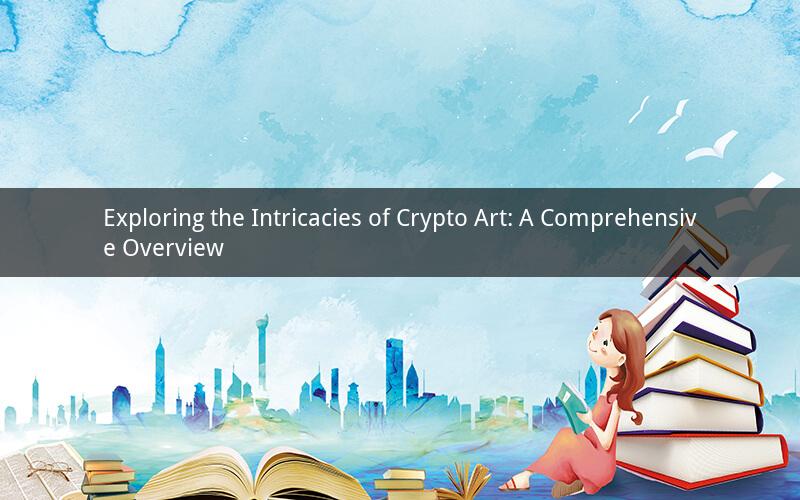
Introduction:
In the rapidly evolving digital landscape, crypto art has emerged as a fascinating and innovative form of expression. With the integration of blockchain technology, artists and collectors have found new ways to create, sell, and own digital artworks. This article delves into the world of crypto art, providing a detailed exploration of its concepts, significance, and potential future developments.
1. Understanding Crypto Art:
Crypto art refers to digital art created, distributed, and sold using blockchain technology. Unlike traditional art forms, crypto art exists in the digital realm and is stored on a decentralized ledger, ensuring its authenticity and ownership. The use of cryptographic techniques makes it nearly impossible to duplicate or alter, providing a sense of security for both artists and collectors.
2. The Blockchain and Crypto Art:
The blockchain serves as the foundation for crypto art. It is a decentralized ledger that records transactions across multiple computers, ensuring transparency and security. By leveraging blockchain technology, artists can create a digital certificate of ownership for their artwork, eliminating the need for intermediaries like galleries or auction houses.
3. Unique Aspects of Crypto Art:
One of the most remarkable aspects of crypto art is its ability to prove provenance. With each transaction recorded on the blockchain, the ownership history of the artwork is transparent and immutable. This feature makes it easier for collectors to verify the authenticity of the artwork and its history.
4. The Rise of NFTs:
Non-fungible tokens (NFTs) have played a significant role in the crypto art scene. An NFT is a unique digital asset that represents ownership and authenticity of a specific item, such as a piece of art. By using NFTs, artists can tokenize their artworks and create a digital scarcity, making them more valuable and collectible.
5. The Benefits of Crypto Art:
There are several benefits associated with crypto art. Firstly, it provides artists with a new revenue stream by allowing them to sell their digital creations directly to collectors. Secondly, collectors can own a piece of art without the need for physical storage or maintenance. Lastly, the transparency and security offered by blockchain technology make the crypto art market more trustworthy and accessible.
6. The Challenges of Crypto Art:
Despite its numerous advantages, the crypto art market is not without its challenges. One of the main concerns is the volatility of cryptocurrencies, which can affect the value of crypto art. Additionally, the digital nature of crypto art raises questions about its long-term preservation and authenticity.
7. The Future of Crypto Art:
The future of crypto art looks promising, with several potential developments on the horizon. As blockchain technology continues to evolve, we can expect more innovative ways to create, sell, and own digital artworks. Moreover, the integration of augmented reality (AR) and virtual reality (VR) may enhance the immersive experience of crypto art, making it even more captivating for collectors and enthusiasts.
Conclusion:
Crypto art has revolutionized the traditional art world by bringing digital creations to the forefront. With its unique characteristics, such as provenance, digital scarcity, and decentralized ownership, crypto art has the potential to redefine the way we perceive and value art. As blockchain technology continues to advance, we can expect the crypto art market to grow and evolve, offering new opportunities for artists and collectors alike.
Questions and Answers:
1. Q: How does blockchain technology ensure the authenticity of crypto art?
A: Blockchain technology ensures the authenticity of crypto art by recording every transaction on a decentralized ledger. This immutable record allows collectors to verify the ownership history and provenance of the artwork.
2. Q: What is the difference between crypto art and traditional art?
A: The main difference between crypto art and traditional art lies in their physical and digital nature. Crypto art exists in the digital realm and is stored on a decentralized ledger, while traditional art is physical and requires storage and maintenance.
3. Q: Can crypto art be duplicated?
A: No, crypto art cannot be duplicated. The use of cryptographic techniques and blockchain technology ensures that each piece of crypto art is unique and can be verified as authentic.
4. Q: How do NFTs contribute to the value of crypto art?
A: NFTs contribute to the value of crypto art by creating a digital scarcity and proving ownership. This uniqueness and authenticity make crypto art more valuable and collectible in the eyes of enthusiasts and collectors.
5. Q: What challenges does the crypto art market face?
A: The crypto art market faces challenges such as cryptocurrency volatility, concerns about long-term preservation, and questions about authenticity. However, as blockchain technology continues to evolve, these challenges may be addressed in the future.